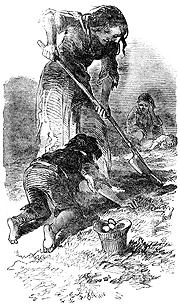![[Link to www.VanGoghGallery.com]](/images/logoh.jpg) |
The Famine |
![[Link to www.VanGoghGallery.com]](/images/logoh.jpg) |
The Famine |
This page presents some references to Internet sources of information on the
great Irish famine of 1846 to 1850 and the resulting emigration from Ireland.
 The
sketch on the left was entitled Searching
for Potatoes in a Stubble Field and was published in The Illustrated
London News of December 22, 1849, with this text:
The
sketch on the left was entitled Searching
for Potatoes in a Stubble Field and was published in The Illustrated
London News of December 22, 1849, with this text:
"Searching for potatoes is one of the occupations of those who cannot obtain out-door relief. It is gleaning in a potato-field—and how few are left after the potatoes are dug, must be known to every one who has ever seen the field cleared. What the people were digging and hunting for, like dogs after truffles, I could not imagine, till I went into the field, and then I found them patiently turning over the whole ground, in the hopes of finding the few potatoes the owner might have overlooked. Gleaning in a potato-field seems something like shearing hogs, but it is the only means by which the gleaners could hope to get a meal."
Vassar College of Poughkeepsie, New York, has published on the Internet a series of articles from The Illustrated London News related to the Irish tragedy of 1845–51. The articles include links to 72 engravings, of which this sketch is one. The sketches can also be found and viewed through the Index to Illustrations. The web page is part of Views of the Famine, a larger collection of articles and sketches from several periodicals, compiled by Steve Taylor, manager of Instructional Media Services at Vassar College, as part of Vassar's Computing & Information Services. In Vassar's famine website, there is a good collection of other materials related to the Famine.
Here are excerpts from an article in the Illustrated London News of July 6, 1850:
"The Tide of Emigration of the United States and to the British Colonies. The great tide of Emigration flows steadily westward. The principal emigrants are Irish peasants and labourers. It is calculated that at least four out of every five persons who leave the shores of the old country to try their fortunes in the new, are Irish. Since the fatal years of the potato famine and the cholera, the annual numbers of emigrants have gone on increasing, until they have become so great as to suggest the idea, and almost justify the belief, of a gradual depopulation of Ireland. The colonies of Great Britain offer powerful attractions to the great bulk of the English and Scottish emigrants who forsake their native land to make homes in the wilderness. But the Irish emigration flows with full force upon the United States. Though many of the Irish emigrants are, doubtless, persons of small means, who have been hoarding and saving for years, and living in rags and squalor, in order to amass sufficient money to carry themselves and families across the Atlantic, and to beg their way to the western states, where they may "squat" or purchase cheap lands, the great bulk appear to be people of the most destitute class, who go to join their friends and relatives, previously established in America. Large sums of money reach this country annually from the United States. Through Liverpool houses alone, near upon a million pounds sterling, in small drafts, varying from £2 or £3 to £10 each, are annually forwarded from America, for poor persons in Ireland, to enable them to emigrate; and the passage-money of many thousands, in addition, is paid in New York. Before the fatal year 1847, the emigration was very considerable; but, since that time, it has very rapidly increased."
Cormac O'Grada, Professor of Economics at University College, Dublin, is the leading economic historian of the Irish famine. His new book, Black '47 and Beyond: The Great Irish Famine in History, Economy, and Memory (Princeton University Press 1999), is a good place to start reading about the famine.
The Great Irish Famine, a curriculum, prepared by the Irish Famine Curriculum Committee of New Jersey in 1996, contains much information on the years 1845 to 1850 in Ireland, and prejudice against the Irish in England and the United States before, during, and after the famine. See also: The Irish Potato Famine on the website of Authentic Ireland Travel.
| The
Famine <http://www.magoo.com/hugh/famine.html> Updated February 28, 2009 |
![[Link to www.VanGoghGallery.com]](/images/potatoesred.jpg) |
Feedback
» Site Search & Directory » © 1999–2008 Hugh McGough » |